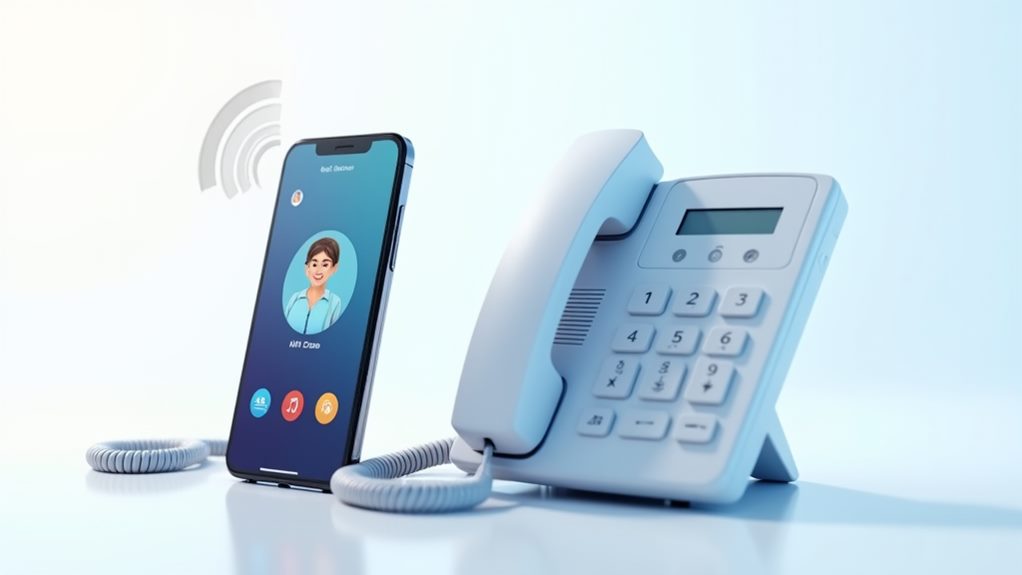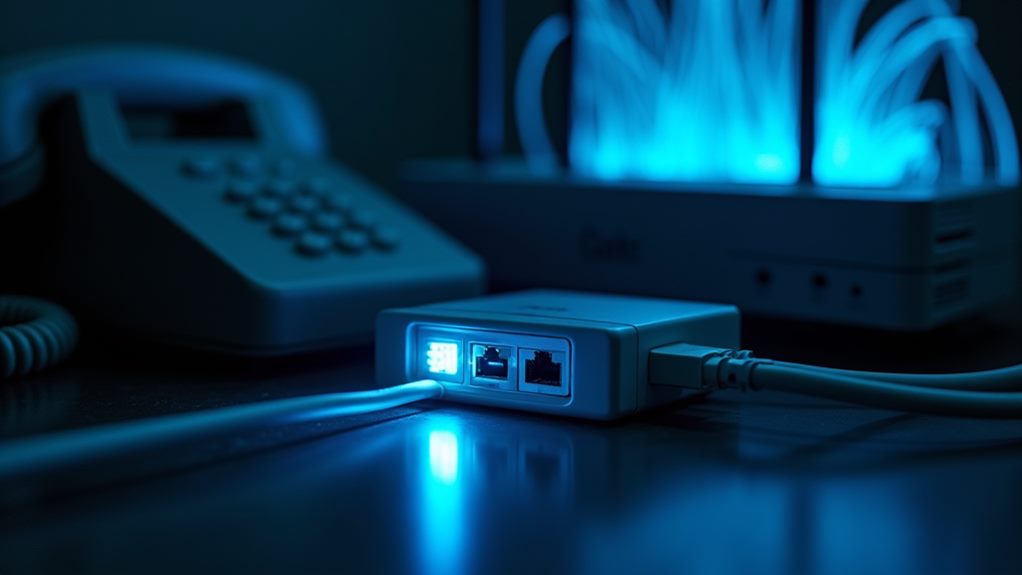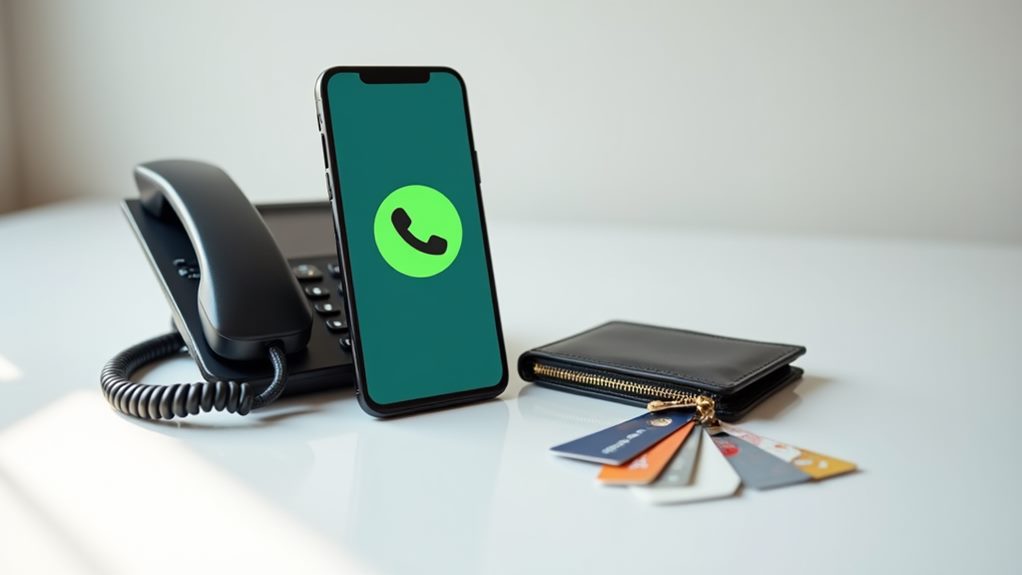You don't need a special phone to use VoIP services, as your existing landline telephone can connect through an Analog Telephone Adapter (ATA). This device converts analog voice signals into digital data packets for internet transmission. If you prefer, you can also use IP phones designed specifically for VoIP or transform your smartphone into a VoIP device using softphone applications like WhatsApp or Skype. Each option requires only a stable internet connection and minimal equipment setup. The variety of VoIP solutions available lets you choose the most cost-effective approach for your specific communication needs.
Understanding VoIP Phone Options

Switching to VoIP telephony doesn't require purchasing specialized hardware in most cases. You can continue using your traditional phone by connecting it to an ATA (Analog Telephone Adapter), which converts your analog voice signals into digital data packets for transmission over VoIP systems. This flexibility allows for a smoother shift to digital communication without disrupting your current phone habits.
For those looking to optimize their VoIP experience, understanding equipment requirements is essential.
For enhanced functionality, you'll find three primary options in the VoIP ecosystem. First, your existing PSTN phones paired with ATAs offer a familiar, cost-effective solution that maintains your current setup while accessing basic VoIP features.
Second, IP phones provide a more advanced alternative, delivering HD voice quality and direct internet connectivity without additional adapters. These devices are specifically engineered for VoIP phone service, offering improved call management features and clearer communication.
Your third option involves soft-phones, which transform your computers and mobile devices into full-featured VoIP communication tools. By installing VoIP applications on your smartphone or tablet, you'll gain the flexibility to make calls from anywhere with an internet connection.
This software-based approach eliminates the need for physical phones entirely, making it an increasingly popular choice for users who prioritize mobility and integration with their existing devices.
Converting Regular Phones
Converting your standard analog phone into a VoIP-enabled device requires only an Analog Telephone Adapter (ATA), which serves as the bridge between traditional telephony and internet-based communication. The ATA efficiently transforms your voice signals from regular phones into digital data packets that can travel through your internet connection, enabling seamless VoIP functionality.
With the right equipment and setup, you can enjoy a thorough solution that enhances your communication capabilities.
You'll find that this conversion process offers a practical way to maintain your existing PSTN phones while embracing modern VoIP technology. The setup is straightforward: connect your ATA to your router or modem, plug in your regular phone, and you're ready to make VoIP calls. This approach eliminates the need to purchase new hardware, making it a cost-effective solution for moving to VoIP service.
When you're ready to switch, you can typically port your existing phone numbers to your new VoIP service, guaranteeing business continuity and maintaining your established contacts.
The ATA guarantees that you retain all the familiar features of your traditional phone while gaining access to enhanced VoIP capabilities. This conversion method represents a practical bridge between legacy telephone systems and modern internet-based communications, offering you the best of both worlds.
Connecting Through Digital Adapters

Digital adaptation through ATAs represents the cornerstone of modern VoIP integration, enabling seamless connectivity between traditional analog phones and internet-based telephony systems.
When you're ready to shift to VoIP technology, you won't need to replace your existing phone equipment, as an Analog Telephone Adapter serves as your bridge to modern telecommunications. With careful selection of VoIP hardware components, including a reliable ATA, you guarantee high call quality and performance. Your VoIP service provider typically includes an ATA in their service package, streamlining your setup process.
You'll simply connect the ATA to your broadband router, and it automatically converts your voice signals into digital packets for transmission over the internet. This conversion process happens instantaneously, allowing you to maintain the familiar feel of your traditional analog phones while leveraging advanced VoIP features.
The beauty of this solution lies in its ability to maximize communication efficiency while minimizing operational costs. You're preserving your investment in current phone systems while gaining access to enhanced VoIP capabilities.
The ATA effectively future-proofs your existing phone infrastructure, assuring you're part of the growing VoIP community without unnecessary hardware expenses. This practical approach to digital transformation makes VoIP adoption accessible and cost-effective for everyone.
Mobile Device VoIP Solutions
When it comes to modern VoIP implementation, your existing smartphone already serves as a complete VoIP solution without requiring additional hardware. Your mobile device transforms into a powerful communication tool through VoIP apps that leverage your internet connection to facilitate voice calls and more.
Popular platforms like WhatsApp and Skype have revolutionized how you can connect with others, offering extensive soft-phone functionalities directly through your smartphone. These applications provide intuitive interfaces with virtual keypads, contact management, and advanced calling features that you'd typically find in traditional phone systems.
To maximize your mobile VoIP experience, you'll need a stable connection through either Wi-Fi or cellular data. High-speed internet guarantees clear audio quality and maintains reliable communication channels during your calls.
While most VoIP apps are freely available on both Android and iOS platforms, some offer premium features that you can access through subscription models. Your smartphone's built-in capabilities eliminate the need for specialized VoIP equipment, making it a cost-effective and practical solution.
The integration of these services into your existing device means you're already equipped to join the growing community of mobile VoIP users.
Cost and Equipment Requirements

While mobile VoIP solutions offer immediate accessibility, many users wonder about the equipment costs for implementing VoIP in their homes or offices.
You'll be pleased to know that shifting to VoIP doesn't require purchasing new phones, as your existing analog phones can seamlessly integrate into a VoIP system through a cost-effective solution known as an Analog Telephone Adapter (ATA).
VoIP services typically provide the necessary software and equipment, including the ATA, making your shift from traditional phone service straightforward and efficient.
This adapter serves as a bridge between your traditional telephones and the VoIP system, eliminating the need for expensive hardware upgrades. While IP phones are available and offer advanced features, they're not mandatory for basic VoIP functionality.
The minimal investment required for implementing VoIP with your current equipment makes it a budget-friendly option for both residential and business users.
You can maintain your familiar phone hardware while gaining access to modern communication features.
This approach allows you to join the VoIP community without the substantial upfront costs typically associated with complete system overhauls, making it an economically sound choice for those seeking to modernize their telecommunications.
Final Thoughts
You don't need a dedicated VoIP phone to make VoIP calls in today's interconnected world. Like trading in your horse-drawn carriage for an automobile, you can transform existing analog phones with ATAs or simply leverage your smartphone's capabilities through VoIP apps. Whether you're using SIP protocols, digital adapters, or softphones, the technical requirements remain minimal – just guarantee you've got a stable internet connection with sufficient bandwidth.

